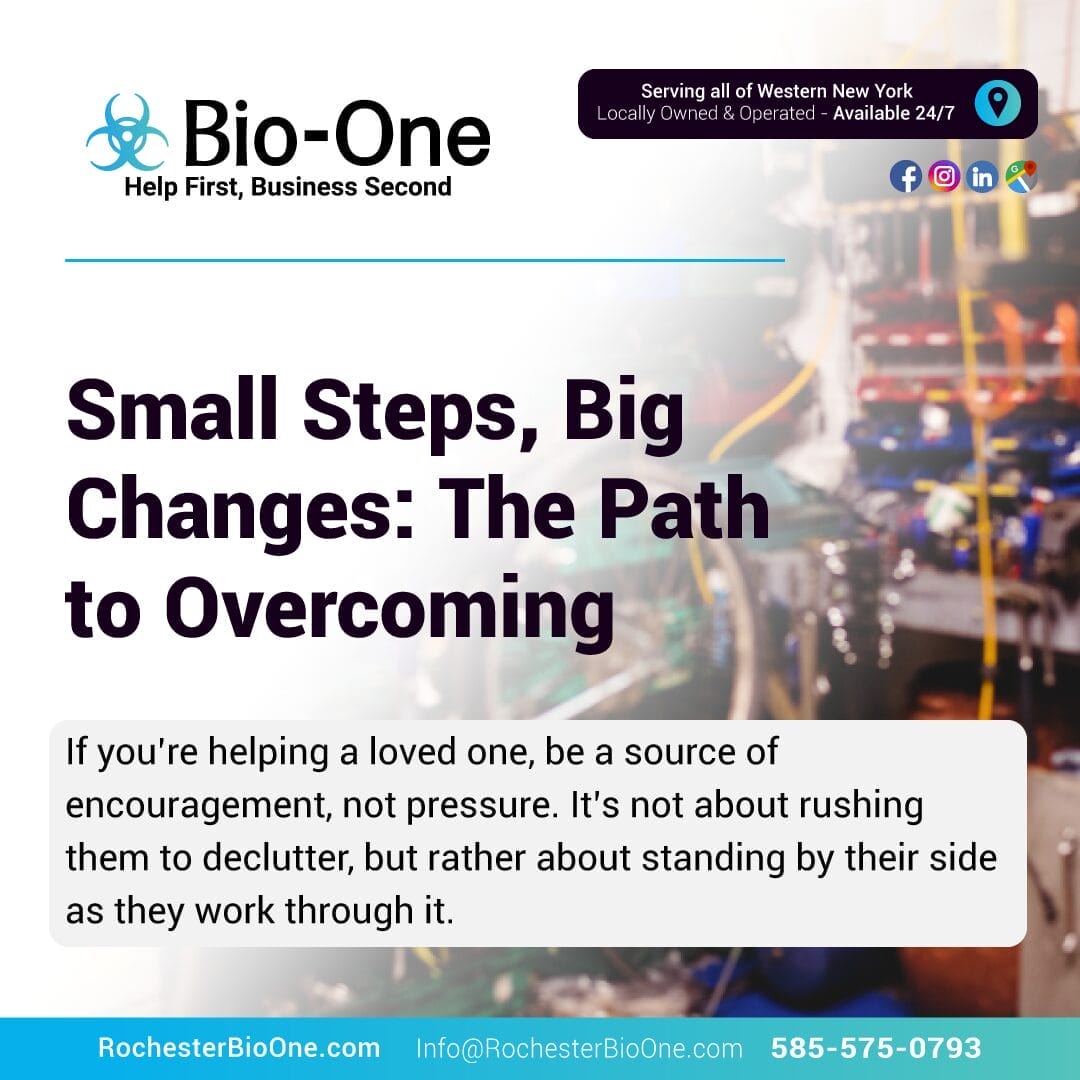
Hoarding cleanup is not just a physical task; it often comes with deep-rooted emotional hurdles that make it feel overwhelming. For individuals dealing with hoarding—or supporting a loved one through it—the process can stir up feelings like guilt, anxiety, or even fear. However, with the right approach, patience, and support, it’s possible to take meaningful steps forward. This blog will walk through practical tips to manage the emotional challenges of hoarding cleanup, offering empathy and encouragement along the way.
Hoarding is rarely just about a “mess.” Items are often tied to emotional attachments, memories, or perceived safety. Telling someone to "just throw it all away" can feel dismissive, even cruel. A sensitive approach is vital—whether you’re helping a loved one or embarking on your own cleanup.
Begin by acknowledging the emotions involved. If you’re helping someone else, listen with patience and without judgment. Recognize that they might feel fear of losing cherished memories or a sense of security tied to their belongings. Respect their attachment to items and assure them that you’re there to support, not to judge.
For those tackling their own hoarding habits, it’s important to practice self-compassion. Remind yourself that needing help doesn’t make you weak or inadequate—it makes you human.
Guilt goes hand in hand with hoarding—whether it’s guilt for letting things accumulate, guilt for needing help, or guilt for parting with items. One way to manage this is by reframing your perspective.
Instead of focusing on what you’re losing, think about what you’re gaining. Decluttering creates space—physically, emotionally, and even socially. Cleaning up might mean more time with loved ones, a safer home environment, or less mental stress from your surroundings.
If you feel guilty discarding items that seem valuable, consider giving them a second life. You could donate to charities or give items to someone who can use them. Knowing that your belongings are helping others can ease the emotional burden of letting go.
Decluttering an entire space can feel impossible if you focus on the big picture. The key is taking it one step at a time. Break the overall cleanup into smaller, manageable tasks.
Start with just one area—like a single drawer, shelf, or corner. Small victories can build momentum. Celebrate the progress you make, no matter how small it feels. Each item sorted, kept, donated, or discarded is a step toward your goal.
A strategy known as the “Four-Box Method” can be helpful. Label four boxes as “Keep,” “Donate,” “Trash,” and “Not Sure.” This approach makes decisions more concrete and manageable. Items in the “Not Sure” box can be revisited later, giving you more time to process emotionally difficult choices.
It’s normal for decluttering to bring on feelings of anxiety. You might worry about making the “wrong” decision or feel overwhelmed at the thought of losing control.
When anxiety strikes, take a moment to pause. Step away for a short break and practice deep breathing to ground yourself. Breathing exercises like inhaling for a count of four, holding for four, and exhaling for four can help calm your mind.
Creating a checklist can also help ease anxiety. Breaking tasks into small, manageable actions can make the process feel more structured and less chaotic. Checking off completed tasks gives a sense of accomplishment and progress, even if the steps are tiny.
You don’t have to go through this alone. Whether it’s family, friends, or professionals, having a support system can make a world of difference.
If you’re helping a loved one, be a source of encouragement, not pressure. It’s not about rushing them to declutter, but rather about standing by their side as they work through it. Sometimes the best support you can offer is simply being present and available.
Professional support can be invaluable, too. Professional organizers, therapists, or specialists in hoarding disorders can offer expert guidance. Therapists, in particular, can help address underlying emotional triggers for hoarding, creating a foundation for long-term change.
Support groups—whether in person or online—provide a safe space to share experiences and gain encouragement from others who understand the struggle.
Self-care is essential when navigating the emotional toll of hoarding cleanup. If you’ve spent hours making tough decisions about your belongings or supporting a loved one, give yourself permission to rest.
Set aside time for activities that relax and rejuvenate you. Whether it’s reading, meditating, taking a walk, or simply sitting quietly for a while, self-care helps you recharge.
For those helping someone else, remember to maintain your own boundaries. While empathy and understanding are vital, burnout can happen if you neglect your own emotional needs.
Progress is progress, no matter how small it might seem. Every cleared space, every tough decision made, and every bag donated deserves recognition. Celebrate what you’ve achieved, whether it’s finishing an entire room or even just sorting through one box.
Reward yourself for milestones, too. It could be as simple as a nice meal, a favorite TV show, or spending time with loved ones in your decluttered space. Positive reinforcement is a powerful motivator and reminds you of why you’re taking these steps.
Hoarding cleanup is an emotional process, but it’s also an opportunity for growth and transformation. By approaching it with sensitivity, managing feelings of guilt and anxiety, and taking small steps, you can make meaningful progress. Remember to lean on your support system, care for yourself along the way, and celebrate every win—even the tiny ones.
You don’t have to overcome these challenges all at once. From organizing and removing clutter to thoroughly cleaning your space, we offer a comprehensive approach tailored to your unique needs. We emphasize discretion, respect, and empathy, ensuring that you feel comfortable and in control throughout the process. Contact us today to learn more about our hoarding cleanup services and how we can create a plan that works for you!
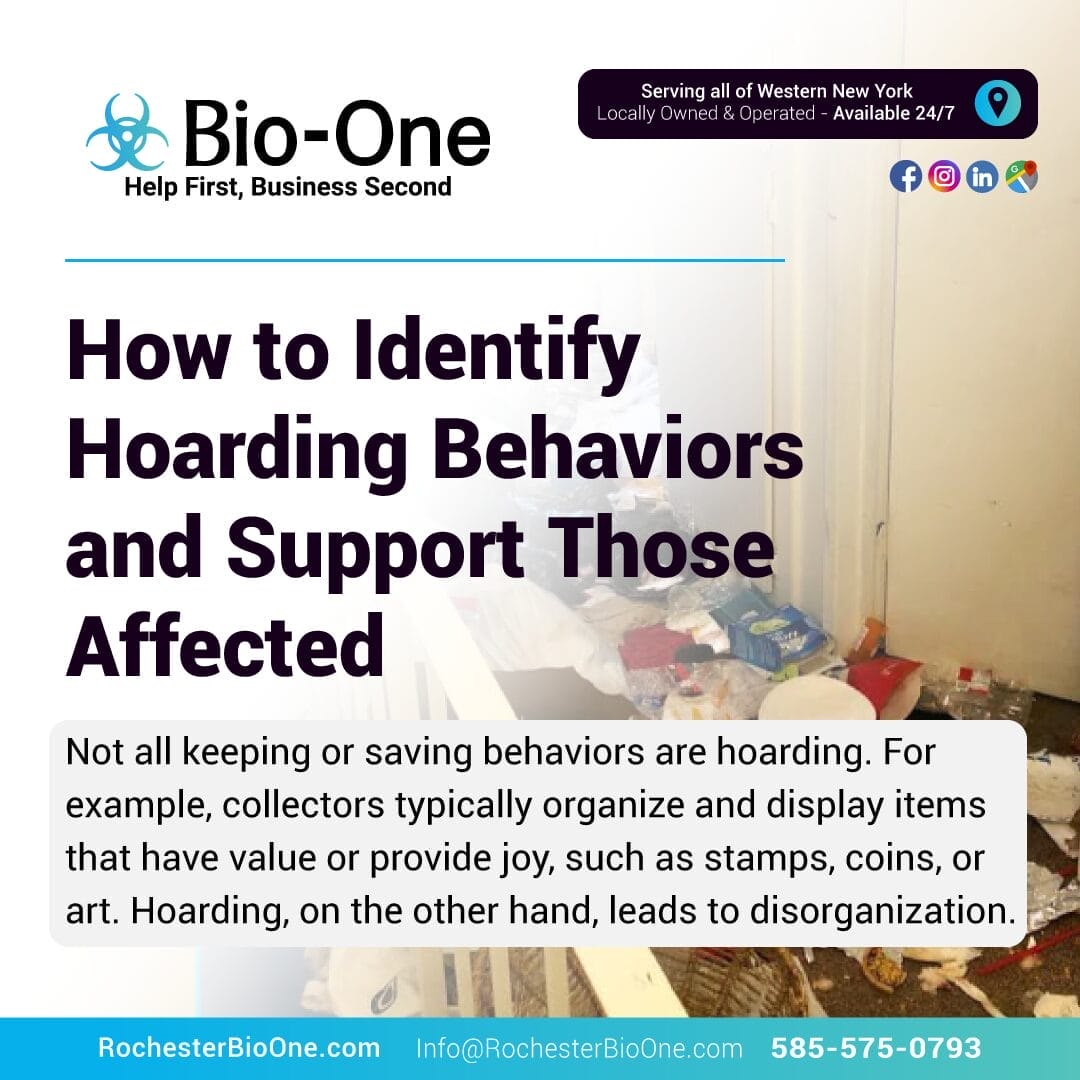
Hoarding is often misunderstood. On the surface, it may seem like someone is merely collecting items or keeping too many possessions for sentimental reasons. However, hoarding is a complex behavior that can deeply affect individuals and their loved ones emotionally, mentally, and physically. This article will take you through the key signs of hoarding, clarify the difference between collecting and hoarding, and provide resources on how to approach this behavior constructively.
Hoarding is not just about clutter or disorganization—it’s a behavioral pattern where an individual accumulates excessive amounts of possessions and experiences difficulty parting with them, regardless of their actual value. Hoarding becomes problematic when it interferes with daily living, safety, and mental wellness. It is officially recognized as a disorder in the Diagnostic and Statistical Manual of Mental Disorders (DSM-5) under Obsessive-Compulsive and Related Disorders.
Not all keeping or saving behaviors are hoarding. For example, collectors typically organize and display items that have value or provide joy, such as stamps, coins, or art. Hoarding, on the other hand, leads to disorganization, overcrowded living spaces, and often distress or shame in showing their environment to others.
Key Differentiators between Collecting and Hoarding:
It's important to recognize hoarding behaviors early to provide the right support. Here are some hallmark signs to look out for.
One of the most prominent behaviors is the inability to throw away possessions, regardless of their usefulness or condition. Even items like old magazines, broken appliances, or empty containers can feel essential to the individual.
Why this happens: Individuals with hoarding behaviors often feel intense anxiety or fear at the thought of disposing of items. Reasons may include emotional attachment, a fear of losing something important, or the belief that the item might be useful someday.
Hoarding typically involves bringing in more possessions than the individual can reasonably use or store. This can include shopping sprees, collecting free items, or bringing in things from the street.
Signs to look out for:
When hoarding behaviors become severe, clutter often spreads to the point where it blocks living areas and makes spaces unusable. For example, a kitchen may no longer function due to piles of items on the counters and stove, or a bedroom bed may be covered with so many possessions that it's no longer usable for sleeping.
Questions to ask:
Hoarding behavior often stems from intense emotional struggles. Many individuals feel embarrassed about their living environment and may avoid inviting others into their homes.
Common emotional signs include:
Overcrowded spaces can lead to serious health and safety issues. For instance, hoarding can increase the risk of falls, create fire hazards, and lead to unsanitary living conditions that may attract pests or mold.
Examples of physical risks from hoarding include:
While hoarding behaviors can seem irrational from the outside, they are often connected to deep emotional needs and past experiences.
Hoarding may stem from underlying mental health conditions such as anxiety, depression, or trauma. For some, acquiring and keeping items provides a sense of control or comfort in response to feelings of chaos or loss.
Common emotional triggers include:
Research indicates that hoarding may also have biological or neurological components. Studies show that brain areas involved in decision-making and emotional regulation may function differently in individuals who hoard.
Approaching someone about their hoarding can be a sensitive matter. It’s crucial to communicate without judgment and provide support rather than criticism.
Hoarding behaviors are deeply tied to emotional and psychological struggles. Provide a listening ear and acknowledge the difficulty the person is experiencing.
What to say:
Instead of emphasizing the mess, focus on safety and health concerns. This can help the person feel less defensive and more open to discussing their behavior.
Hoarding is a serious condition that often requires the help of qualified professionals. Mental health treatments like cognitive-behavioral therapy (CBT) have been shown to help individuals manage their hoarding behaviors.
Helpful Resources
Large-scale cleanup attempts can overwhelm individuals who hoard. Instead, focus on creating small goals like clearing one area or discarding one type of item.
Identifying hoarding behaviors is the first step toward addressing a challenge that can feel insurmountable. Whether you're a mental health professional aiming to provide effective treatment, a family member wondering how to approach a loved one, or someone who recognizes these signs in yourself, know that there are solutions and compassionate resources available.
Remember, progress takes time and patience. Tackling hoarding requires support, understanding, and professional guidance to overcome the emotional roots of these behaviors and build a safer, healthier life.
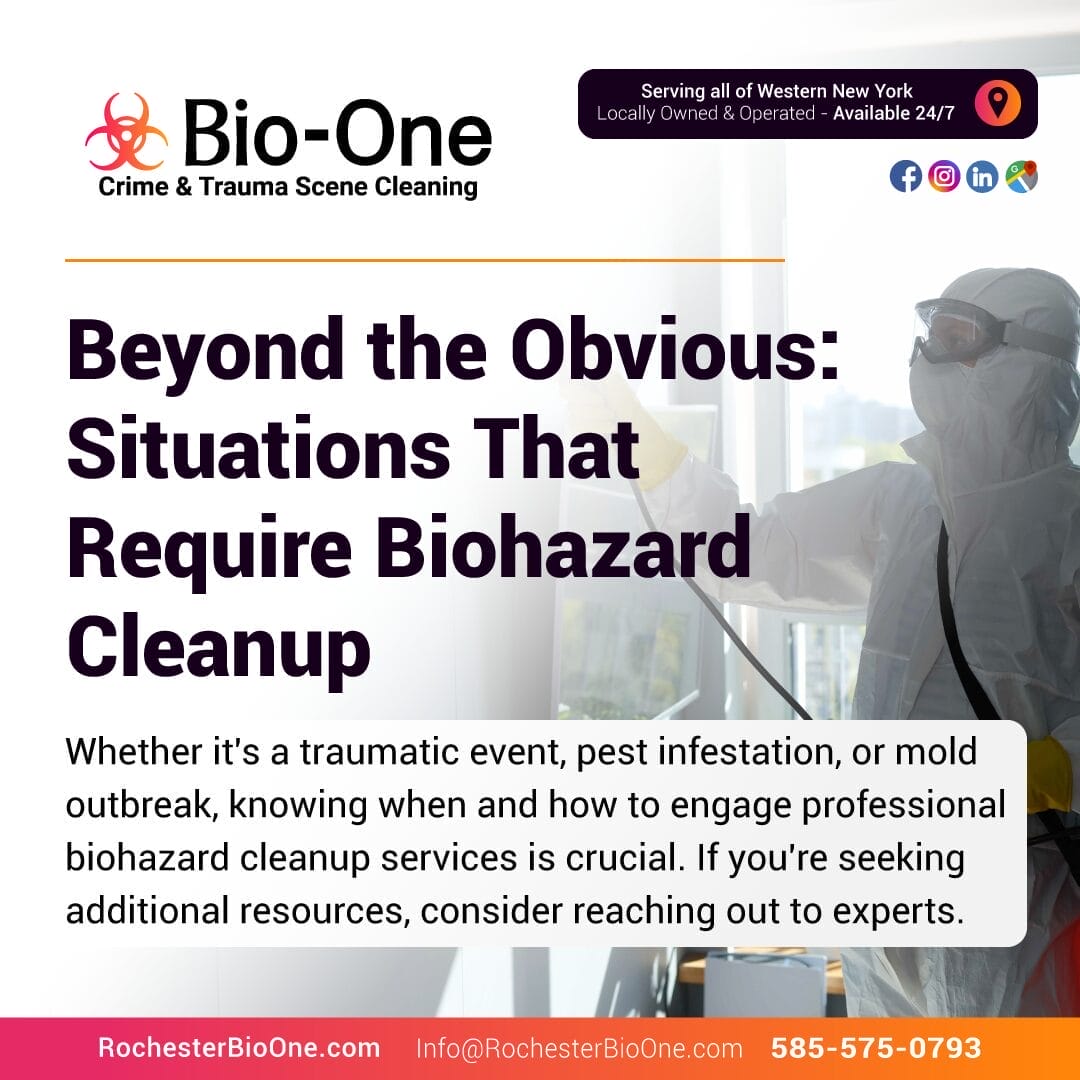
When most of us think about biohazard cleanup, the first images that pop into our heads are usually crime scenes or industrial accidents. However, the reality is that unexpected biohazard situations can arise in unexpected places and circumstances. Whether you're a homeowner, property manager, or health professional, understanding these scenarios is essential for your safety and the safety of those around you. Let's go through the less obvious situations that might require professional biohazard cleanup services, so you have valuable insights and practical information to manage these situations effectively.
Biohazards are biological substances that pose a threat to the health of living organisms. These include bacteria, viruses, fungi, and other microorganisms that can cause disease in humans and animals. Cleaning up this type of waste requires specialized knowledge and equipment to ensure that the contaminants are removed and disposed of safely.
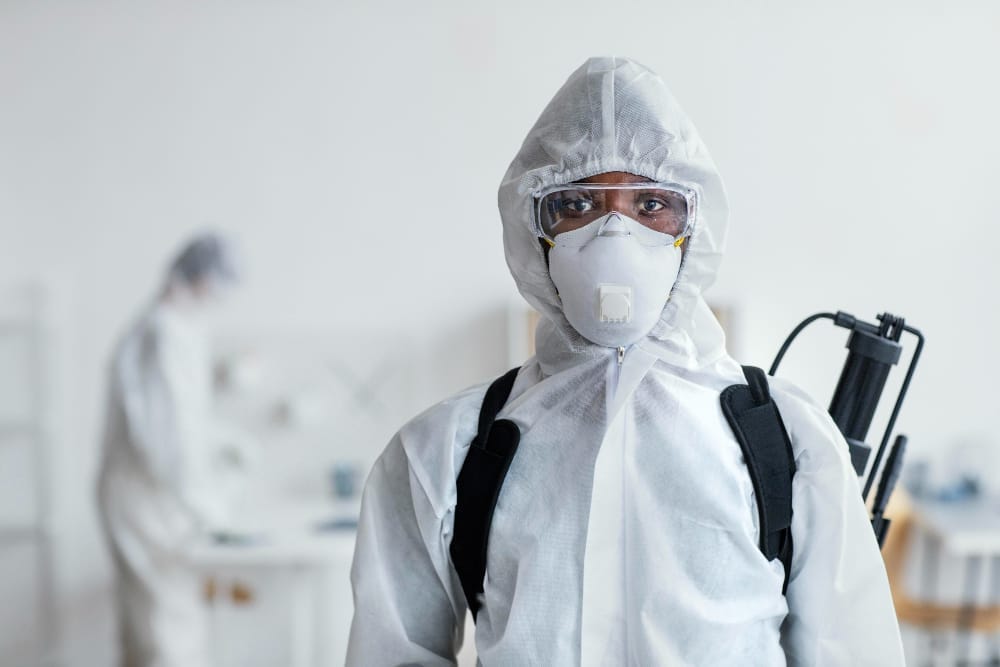
Though it might be sensationalized, incorrect handling and inadequate cleaning may result in serious health risks, including infections and disease. While some cleaning tasks can be handled with regular household cleaning supplies, biohazard situations demand specialized attention. Recognizing these situations is the first step to ensuring your environment remains safe and healthy.
One often overlooked situation that necessitates biohazard cleanup is unattended deaths. These tragic events occur when someone passes away without being discovered for an extended period. During this time, the body begins to decompose, releasing fluids and potentially harmful pathogens into the surrounding area.
Decomposition is a natural process, but it poses significant health risks if not managed properly. Pathogens from the body can spread through the air and surfaces, creating a hazardous environment.
Finding an unattended death on your property can be overwhelming, so the best thing you can do is leave the job to trained professionals, to ensure the area is made safe and habitable once more. Attempting to clean the area yourself is not recommended, as it can expose you to potentially harmful pathogens.
Hoarding can also present unexpected biohazard challenges. When people hoard, they often accumulate large amounts of items, including food waste and other organic materials. Over time, these materials can attract pests and harbor bacteria, creating a hazardous environment.
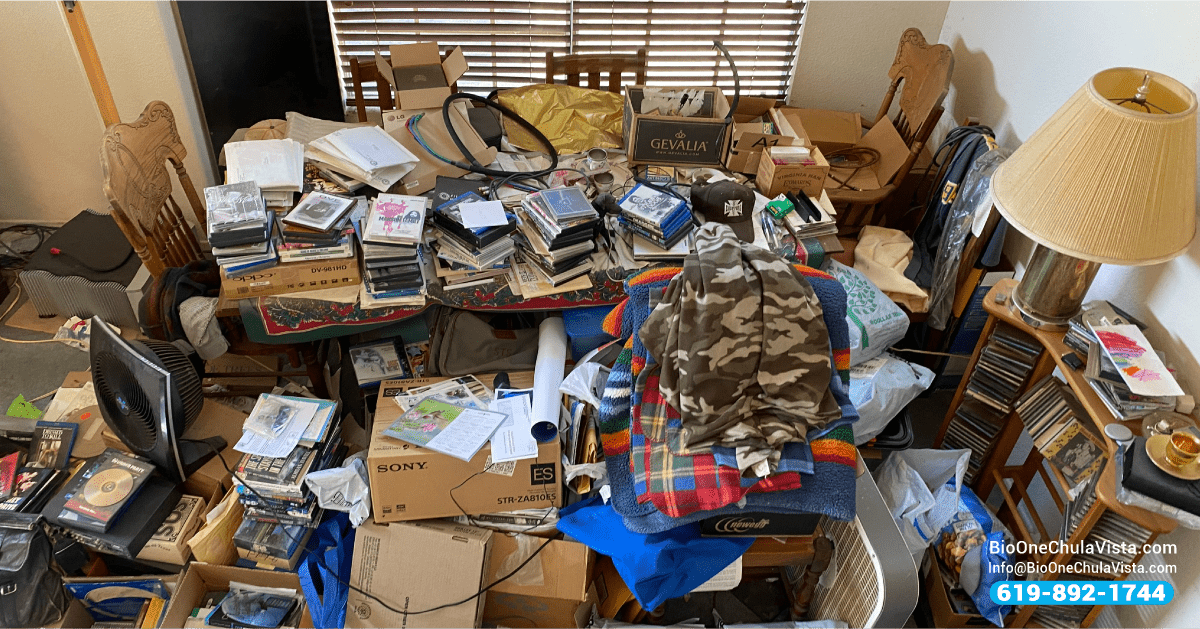
The presence of mold, decaying food, and rodent infestations are common in hoarding situations. These conditions may cause respiratory issues, skin irritations, and other health problems for anyone entering the space.
Addressing a hoarding situation requires sensitivity and care. It's important to approach the individual involved with empathy and understanding, as hoarding is often linked to mental health issues. At Bio-One of Rochester, we have a dedicated team who can not only help you with the physical aspects of a hoarding situation but also assistance in connecting with mental health resources for long-term support and recovery.
Animal infestations involving rats, bats, or birds, can lead to biohazard conditions in a property. These animals often carry diseases that can be transmitted to humans through their droppings, urine, or nesting materials. Once an infestation is identified, it's crucial to address not only the removal of the animals but also the cleanup of their waste.
Droppings from rodents and birds can harbor pathogens like hantavirus and histoplasmosis. Professional biohazard cleanup teams have the experience and equipment to safely remove these contaminants, ensuring the property is safe for human occupancy.
It's important to understand that simply removing the animals does not eliminate the biohazard risk. Thorough cleanup and disinfection are necessary to prevent the spread of disease and ensure the property is restored to a safe condition.
Sewage backups are unexpected biohazard situations that may not immediately come to mind when thinking about biohazards, but they indeed qualify. When sewage backs up into a property, it brings with it a host of harmful bacteria and viruses. Exposure to these pathogens can lead to serious health issues, including gastrointestinal illnesses and infections.
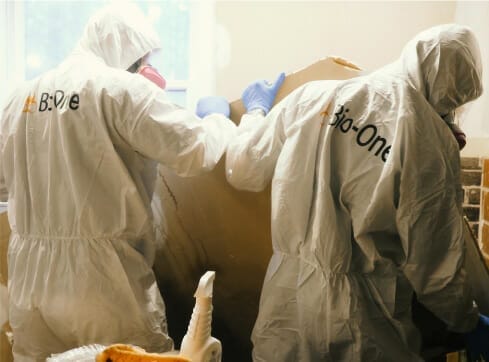
The odors associated with sewage backups are often overwhelming, but the invisible pathogens are the real danger. Professional biohazard cleanup services can quickly and effectively address the situation.
With the rise in illegal drug manufacturing, properties used as drug labs present significant biohazard challenges. The chemicals used in drug production are often toxic and can leave behind hazardous residues. These residues can permeate walls, floors, and furniture, making the environment unsafe for future occupants.
Mold infestations are a common issue in homes and properties, particularly in areas with high humidity levels. While not all molds are hazardous, certain types can produce toxins that pose a risk to human health. Mold spores can also trigger allergic reactions and respiratory issues in sensitive individuals.
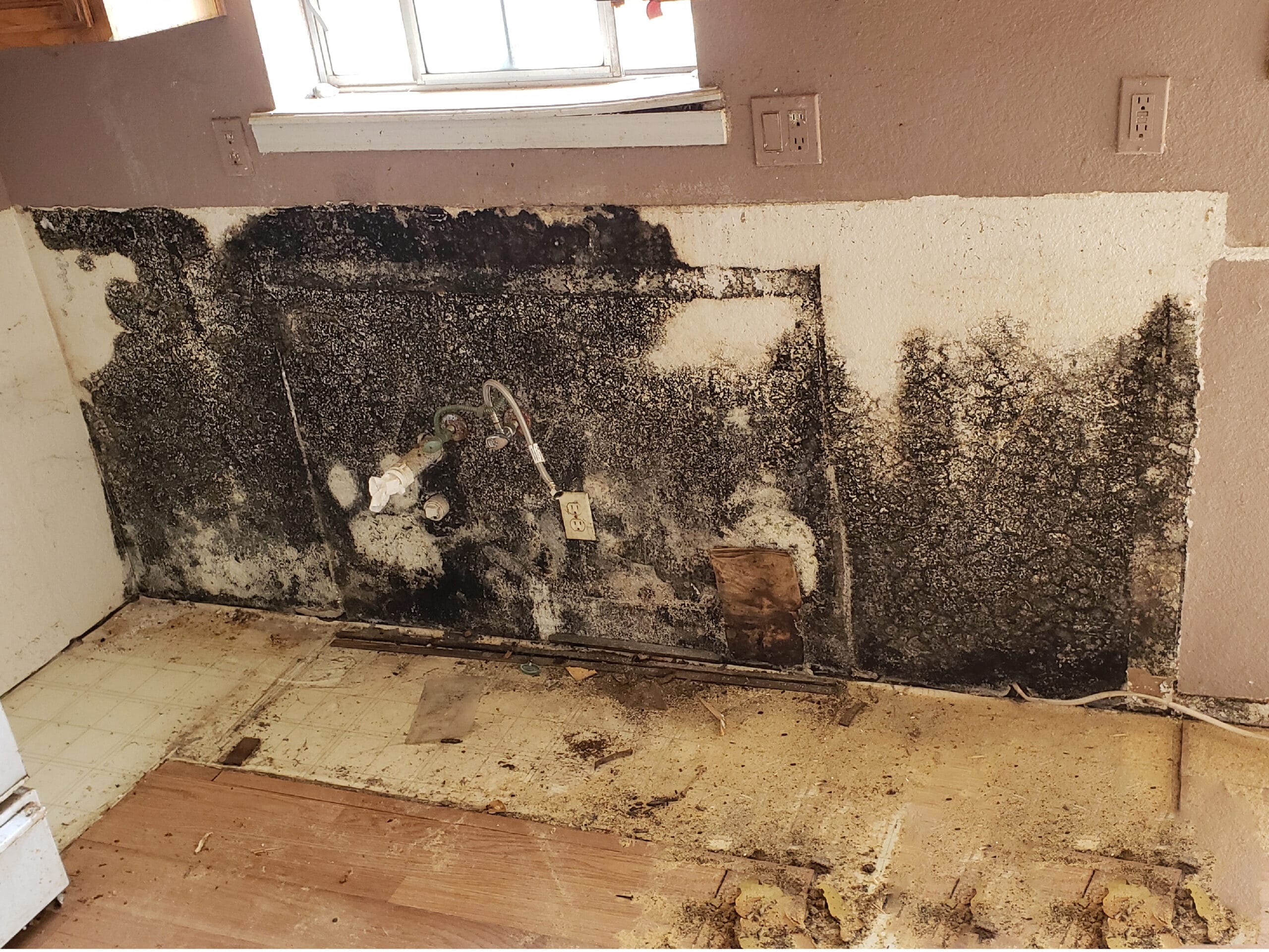
For homeowners and property managers, dealing with mold can be challenging. However, it's important to address the issue promptly to prevent further growth and potential health risks. Engaging professionals ensures that the cleanup is thorough and effective.
While crime scenes are often what we associate with biohazard cleanup, it's important to highlight this situation due to its specific requirements. Crime scene cleanup involves the removal and decontamination of blood, bodily fluids, and other potentially infectious materials. It also requires strict adherence to safety and legal protocols.
Workplace accidents, especially in industrial settings, can also require biohazard cleanup. These accidents may involve exposure to hazardous chemicals or bodily fluids, necessitating specialized cleaning procedures to ensure the safety of all employees.
While some scenarios are more apparent, others, such as unattended deaths, hoarding situations, and animal infestations, may not be immediately recognized as requiring professional intervention. By engaging professional biohazard cleanup services, you can ensure that these situations are handled with care and expertise, minimizing risk to human health and the environment.
If you're faced with unexpected biohazard situations, don't hesitate to reach out to experienced professionals at Bio-One of Rochester, who can provide the necessary support and guidance to restore your property to a safe and habitable condition. Call for a free estimate in all of Western New York!

Dealing with a sewage backup can be a homeowner or property manager's worst nightmare. Not only is it unpleasant and stressful, but it can also be costly to fix and may cause extensive property damage if left unchecked. The good news? Many of these issues are entirely preventable with the right knowledge and practices.
This blog will help you understand common causes of sewer backups and offer practical tips to prevent them. By taking a proactive approach, you can protect your home and provide peace of mind.
Before we get to the tips, it’s helpful to know what typically causes sewage problems in the first place. Understanding these culprits can help you better prevent them:
Understanding these causes sets the foundation for taking informed steps to prevent problems.
It might seem obvious, but in a busy household, it's easy to forget. Toilets are designed for human waste and toilet paper—nothing else. Wipes labeled as "flushable," feminine hygiene products, and paper towels are notorious culprits for clogging sewer lines.
Tip: Place a small trash bin in each bathroom to encourage proper disposal of non-flushable items.
When grease or oil is washed down the drain, it cools and hardens inside your pipes. Over time, this sticky residue builds up and restricts water flow.
Tip: Pour leftover grease into a disposable container, such as an old jar, and throw it away in your trash instead.
Routine maintenance can catch small issues before they escalate into costly backups.
Tip: Schedule professional sewer line inspections every few years, especially if your home is older or has large trees nearby. Experts can use cameras to spot blockages or cracks early.
A backwater valve is a simple yet effective device that prevents sewage from backing up into your home. It’s a wise investment, particularly if you live in an area prone to flooding.
Tip: Ask your plumber about installing a backwater valve to provide an added layer of protection.
Trees can be a beautiful addition to your property, but their roots often spell trouble for underground sewer lines.
Tip: Avoid planting trees or bushes near your sewer lines. If you’re unsure where your sewer lines run, consult a professional service.
Clogged gutters and yard drains can lead to standing water, which might infiltrate your sewer system during storms.
Tip: Regularly clean out leaves and debris from your gutters and outdoor drains, especially before rainy seasons.
If you’ve noticed slow drainage or frequent clogs, don’t delay—this may be a warning sign of an impending backup. A professional sewage cleaning service can provide a comprehensive assessment and preventative cleaning to keep your system in top condition.
Tip: Don’t wait for an emergency. Preventative cleanings can save you significant stress and expense later on.
Even with the best preventative measures, sewage backups can still happen. If the worst occurs, stay calm and follow these steps to minimize damage and ensure your safety:
Sewage backups don’t just threaten your property—they can also disrupt the comfort and safety of your home. Thankfully, you can avoid many common issues by following these simple prevention tips. Small changes, like watching what you flush or scheduling routine maintenance, can make a big difference in the long run.
If you want professional support in keeping your sewer system healthy, don’t hesitate to reach out. Our dedicated cleaning experts are here to help with compassionate, professional service that restores peace of mind. Protect your home and your family—contact us today for a free consultation.
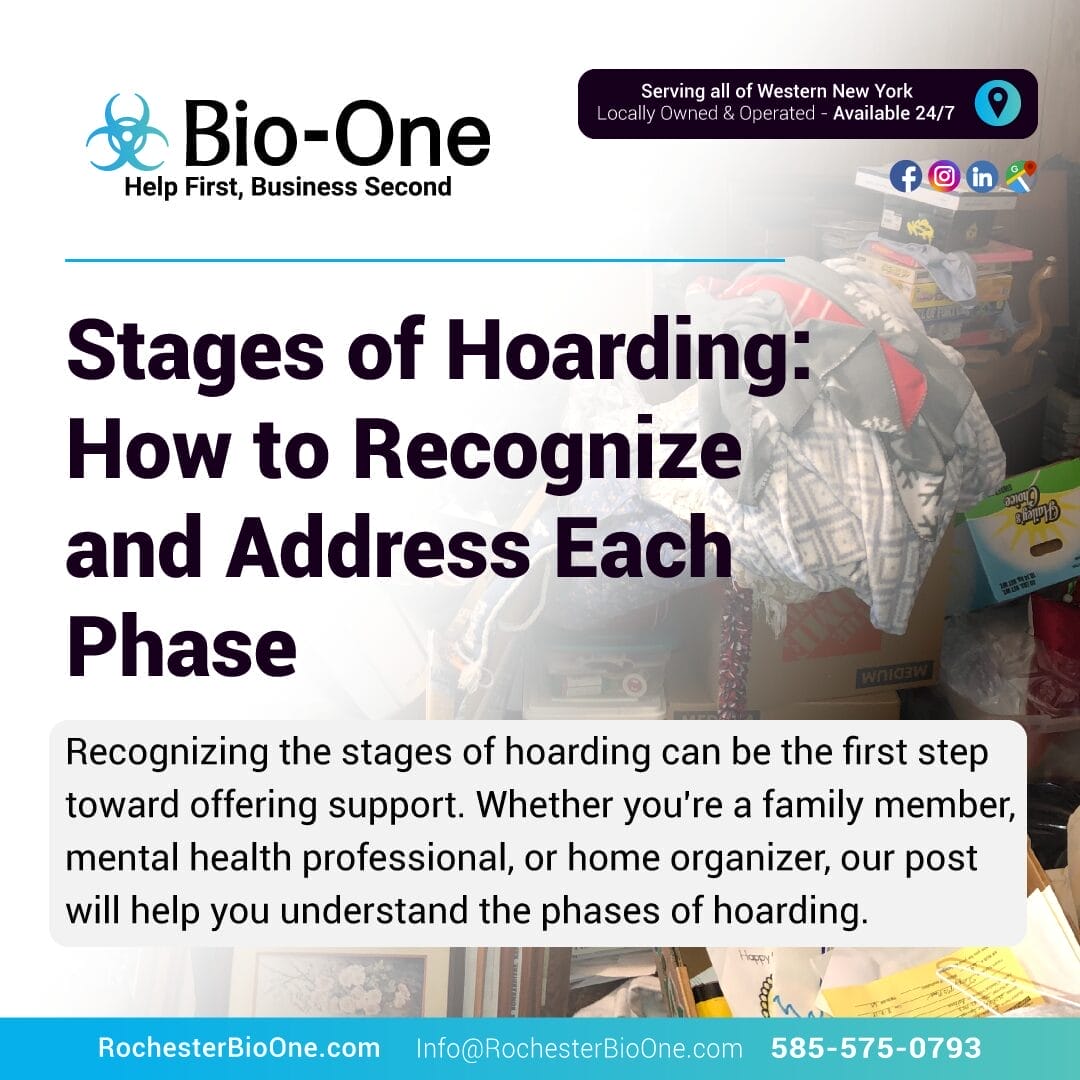
Hoarding is more than just clutter. It's a challenging mental health issue that affects not only the individual but also their loved ones and living environment. Recognizing the stages of hoarding can be the first step toward offering support and finding solutions. Whether you're a family member, mental health professional, or home organizer, this guide will help you understand the phases of hoarding, how they progress, and actionable ways to intervene compassionately.
Hoarding is a behavioral disorder characterized by persistent difficulty discarding possessions, regardless of their value. This results in excessive accumulation of items, which can clutter living spaces and significantly impair daily functioning. It often stems from anxiety, attachment to items, or a fear of waste, and typically worsens without proper intervention.
According to the International OCD Foundation, about 1 in 20 people exhibit hoarding behaviors to some degree, meaning many homes are silently struggling with this issue.
At this initial stage, the signs of hoarding may seem minor or easy to overlook. A home in this phase typically appears lived-in, with some clutter in areas like countertops, entryways, or tables.
Recognizable Signs:
How to Address It:
Encourage open communication with warmth and empathy. Gently discuss the importance of tidying up and help sort through clutter in small, manageable steps. Professional help may not yet be needed, but cultivating healthy organizational habits can prevent the situation from escalating.
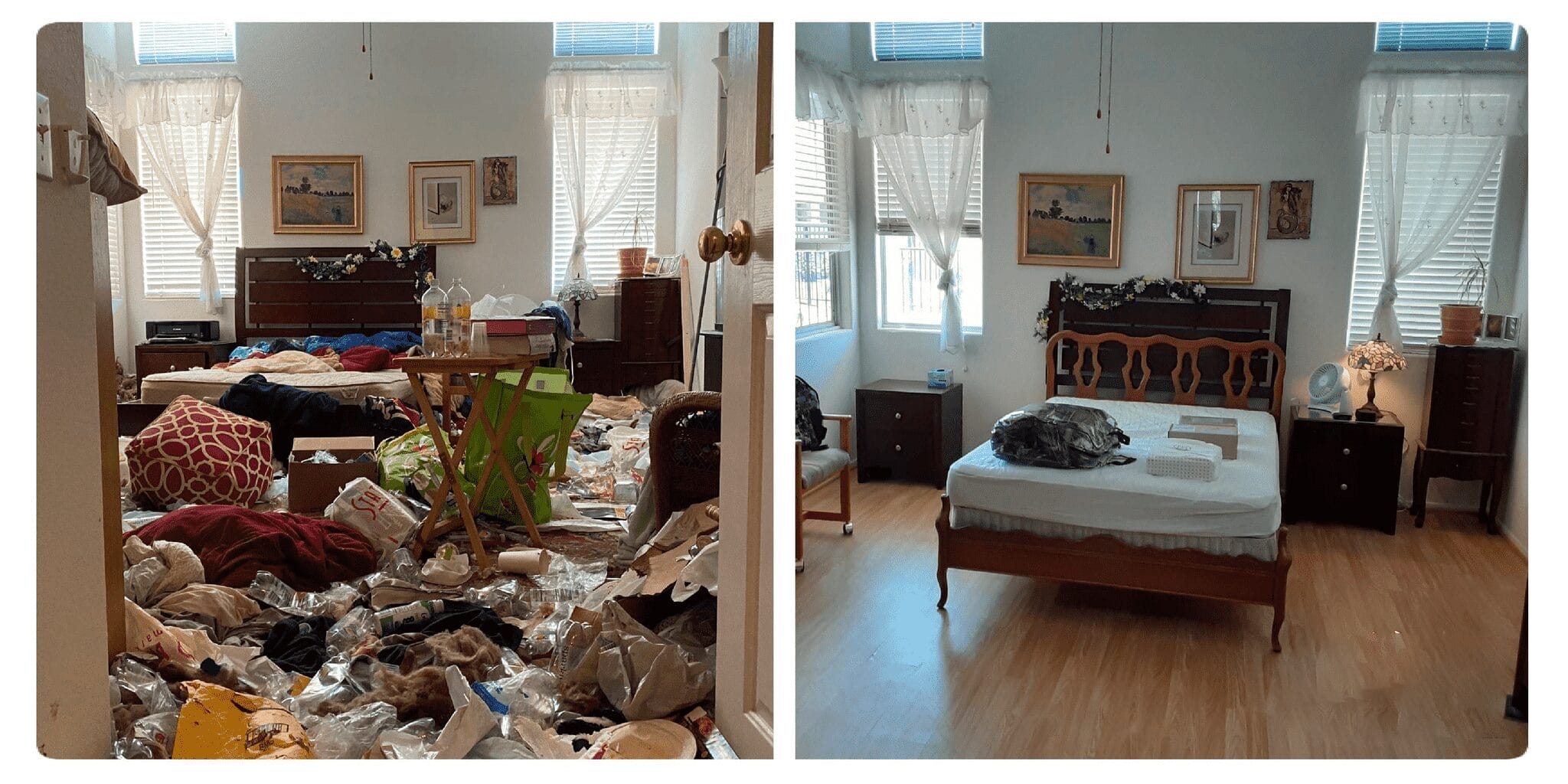
Stage 2 shows a more pronounced amount of clutter. Rooms may begin to lose their intended functionality, and signs of neglect in household maintenance might appear.
Recognizable Signs:
How to Address It:
This is a good time to partner with a home organizer or cleaning service that specializes in compassionate assistance. Professionals can help make the decluttering process feel less overwhelming while respecting the individual’s emotional connection to their possessions.
Stage 3 marks a critical tipping point. Clutter now affects the daily functioning of the home, and the health and safety of its occupants may be compromised.
Recognizable Signs:
How to Address It:
At this phase, it is important to involve both mental health professionals and specialized hoarding cleanup teams. Compassionate and discreet services can ensure the environment is restored safely, while counseling or therapy can address the emotional roots of hoarding behavior.
At this point, inhabiting the home becomes increasingly difficult—if not impossible—due to severe accumulation. Critical areas like kitchens, bathrooms, and bedrooms may no longer be usable.
Recognizable Signs:
How to Address It:
Interventions must go beyond physical cleanup. A coordinated approach involving mental health professionals, cleanup specialists, and family support can create a path forward. It’s essential to focus on rebuilding trust and offering long-term help for the individual’s well-being.
The final stage represents extreme hoarding conditions that pose significant risks to health, safety, and personal relationships. Individuals at this stage often isolate themselves, and their homes may face condemnation or eviction threats.
Recognizable Signs:
How to Address It:
Stage 5 requires delicate but firm intervention. Professionals specializing in severe hoarding situations are crucial at this stage. These teams combine technical skills with empathy to restore the home safely and provide supportive aftercare. Counseling remains a long-term necessity to help prevent recurrence.
If you or a loved one is struggling with hoarding tendencies, it's important to remember that you are not alone, and there is support available to help navigate this challenging condition:

At Bio-One of Rochester, we understand the unique challenges that individuals and families face when dealing with hoarding. Our compassionate team of professionals is here to provide you with the support and assistance you need to navigate this difficult condition.
We specialize in hoarding cleanup and restoration services, offering a comprehensive approach that prioritizes both the physical and emotional well-being of our clients. With years of experience and a deep understanding of the complexities of Hoarding Disorder, we handle each situation with professionalism, empathy, and respect.
We approach every situation with sensitivity, recognizing that each person's journey is unique. Whether you need assistance with clutter removal, organization, or deep cleaning, we are here to help.
If you or someone you know is struggling with hoarding, trust Bio-One of Rochester to provide the compassionate and professional assistance you need.

For many, hoarding isn't simply about accumulating stuff; it's a psychological condition that can significantly impact the quality of life. This blog post takes you on a compassionate and informative exploration of the five stages of hoarding. We'll uncover what differentiates a mild clutter problem from a major crisis, providing insights, practical tips, and real-life examples. By the end of this read, you'll have a clearer perspective on hoarding and actionable strategies to assist yourself or others!
Hoarding affects around 2-6% of the population and can cause significant distress and impairment. Hoarders often form emotional attachments to their possessions, viewing them as extensions of themselves. This makes the thought of parting with items overwhelmingly painful. It's not uncommon for hoarders to feel embarrassment or guilt about their living conditions, further complicating the problem.
The first stage of hoarding begins innocuously with mild clutter accumulation. Most people have clutter to some degree, but in this stage, it's more about the gradual build-up of possessions. People may start to collect items with the best intentions, such as magazines, clothes, or kitchen gadgets they plan to use "someday."
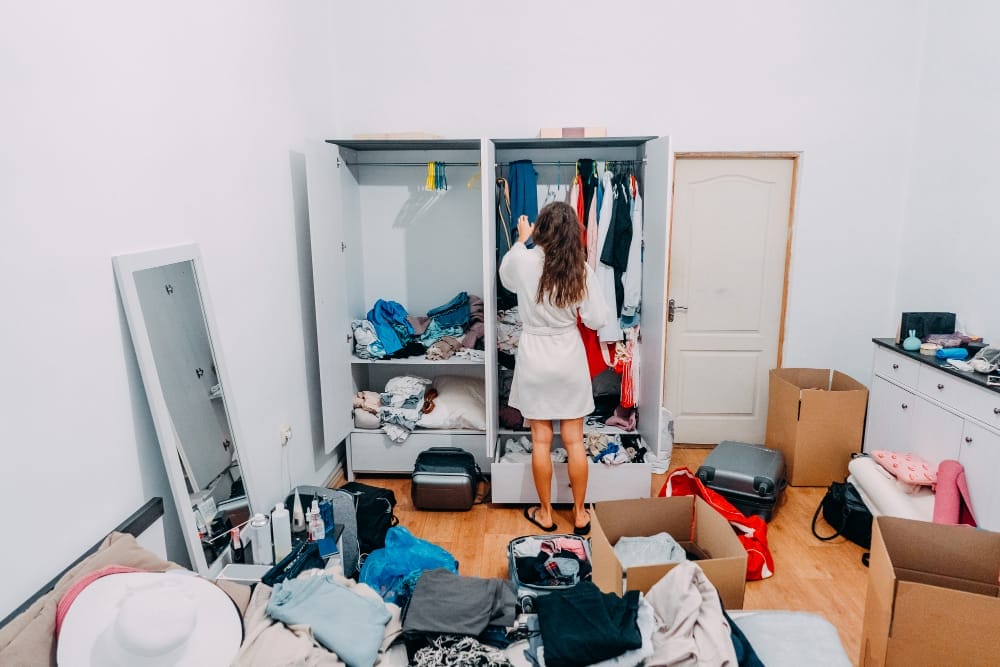
While this phase might seem harmless, it can be the starting point of a more severe problem. The challenge lies in recognizing when clutter shifts from being a simple organizational issue to an early sign of hoarding tendencies. Regular decluttering routines can often help manage this stage effectively.
However, if you notice a reluctance to part with items or a growing attachment to seemingly insignificant possessions, it might be time to seek guidance. Home organizers can play a pivotal role in helping individuals establish systems to manage their belongings, preventing further escalation.
During the second stage, the difficulty in discarding items becomes more pronounced. Individuals may start to feel anxiety or distress at the mere thought of throwing things away. The clutter begins to multiply, gradually overtaking living spaces and impacting daily life.
This stage can be challenging for family members who may not understand the emotional connection hoarders have with their possessions. It's essential to approach the situation with empathy and patience. Open conversations about the emotional significance of items can lead to more supportive interventions.
Moreover, therapists or specialized organizers, might be required to address the underlying issues. Cognitive-behavioral strategies can be particularly effective in helping individuals confront the fears associated with discarding possessions.
Stage three marks a noticeable change, as clutter begins to dominate living spaces. Rooms that were onc
e functional become unusable, often filled with stacks of items that obstruct pathways and create safety hazards. Daily activities such as cooking, cleaning, or even sleeping might become challenging.
When helping someone at this stage of hoarding, this one presents a significant opportunity to implement organizational strategies that empower individuals to regain control of their environment. It's not just about removing items; it's about creating a system that prevents the regrowth of clutter.
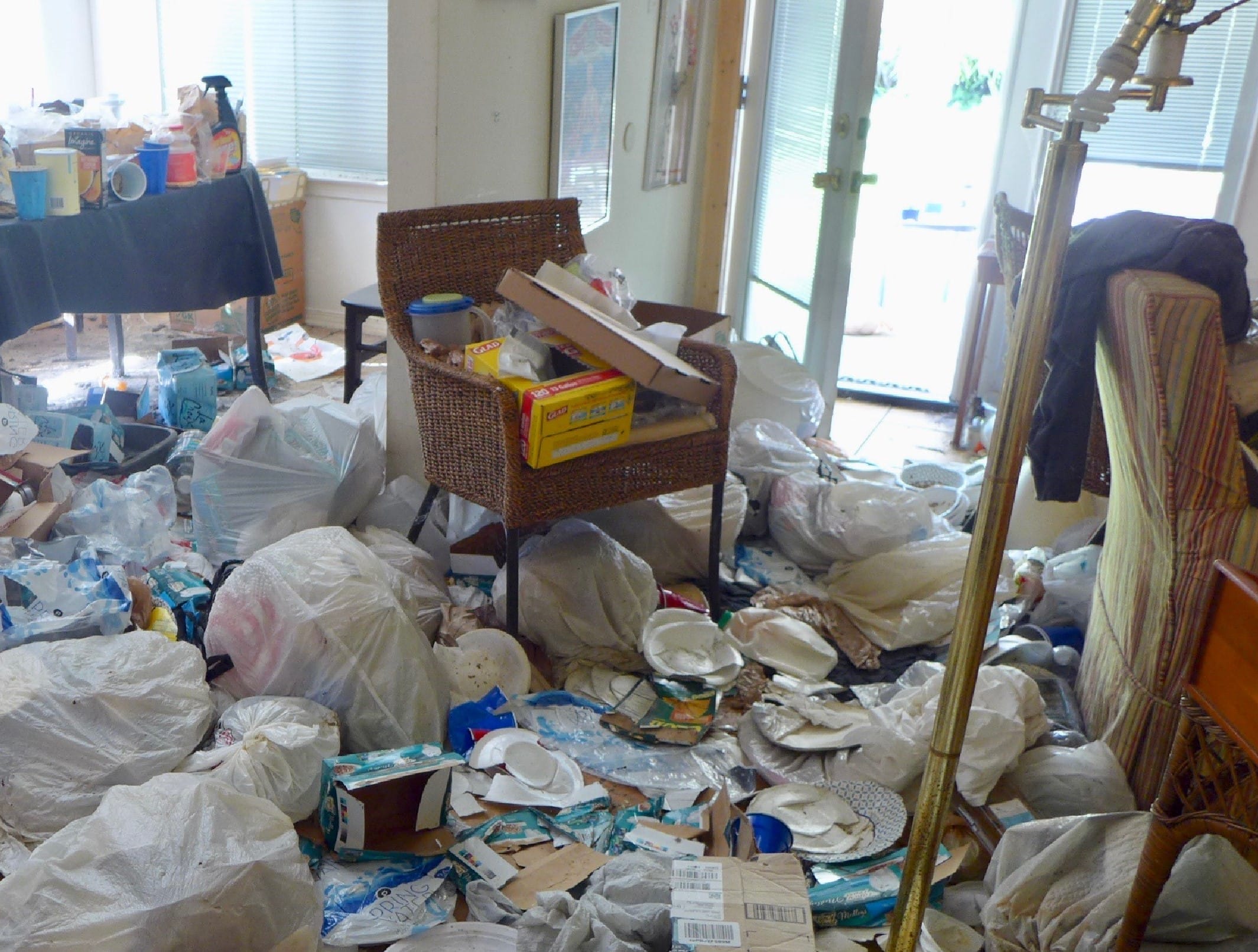
Family support is crucial during this stage. Encouraging open dialogue and participating in the decluttering process can alleviate some of the anxiety experienced by the hoarder. Remember, patience and understanding are key, as progress may be slow but meaningful.
The fourth stage sees an increase in distress and social isolation. The embarrassment about living conditions usually causes hoarders to withdraw from friends and family, further exacerbating the problem. Social interactions decrease, and the clutter becomes a source of shame.
It's imperative for loved ones to maintain lines of communication and offer non-judgmental support. Encouraging participation in social activities or seeking professional help can be vital steps toward breaking the cycle of isolation.
Community resources, including support groups, can also provide valuable assistance. Connecting with others who understand the struggles of hoarding can instill a sense of belonging and offer practical advice from shared experiences.
Reaching stage five represents a significant crisis point where the clutter severely impacts quality of life. Health and safety risks emerge, such as fire hazards or rodent infestations, and emotional well-being suffers dramatically. Relationships may become strained, and professional intervention is often necessary.
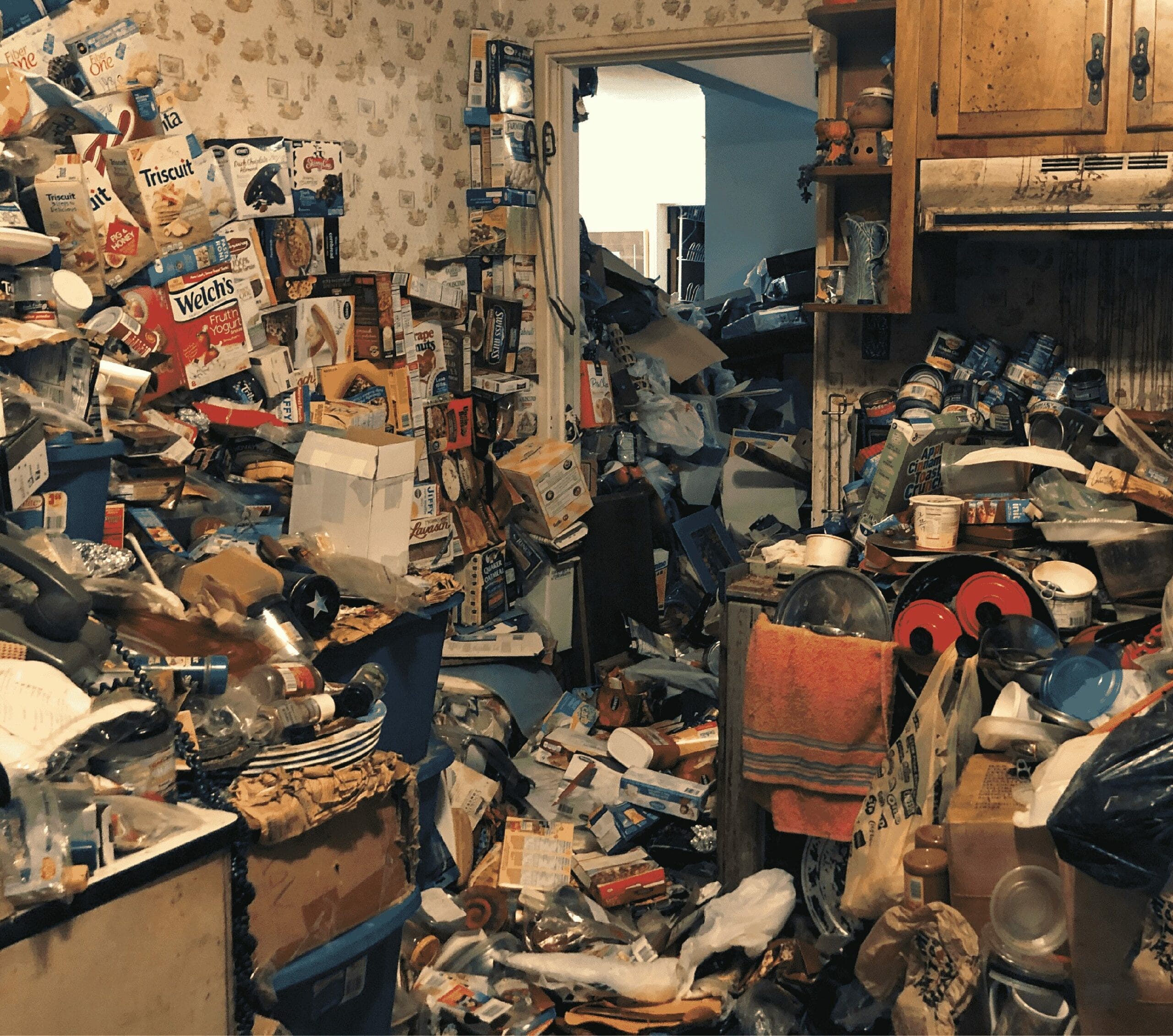
Addressing this stage requires a multi-faceted approach. Mental health professionals, organizers or hoarding cleanup companies, and sometimes even legal or housing authorities may need to collaborate to create a comprehensive plan. The focus should remain on the individual's well-being, ensuring they have access to the resources and support needed.
Recovery from this stage is possible with consistent effort, compassionate care, a strong support network, and of course, help from qualified mental health professionals.
If you or a loved one is struggling with hoarding, know that help is available. Bio-One offers professional and compassionate hoarding cleanup services to assist individuals in decluttering and organizing their homes. Our trained technicians understand the sensitive nature of hoarding and work with them to create a customized plan that prioritizes their well-being. We also offer support for emotional and mental health through our connections with local therapists and support groups.
Don't let hoarding take over your life. Reach out to Bio-One for assistance today!
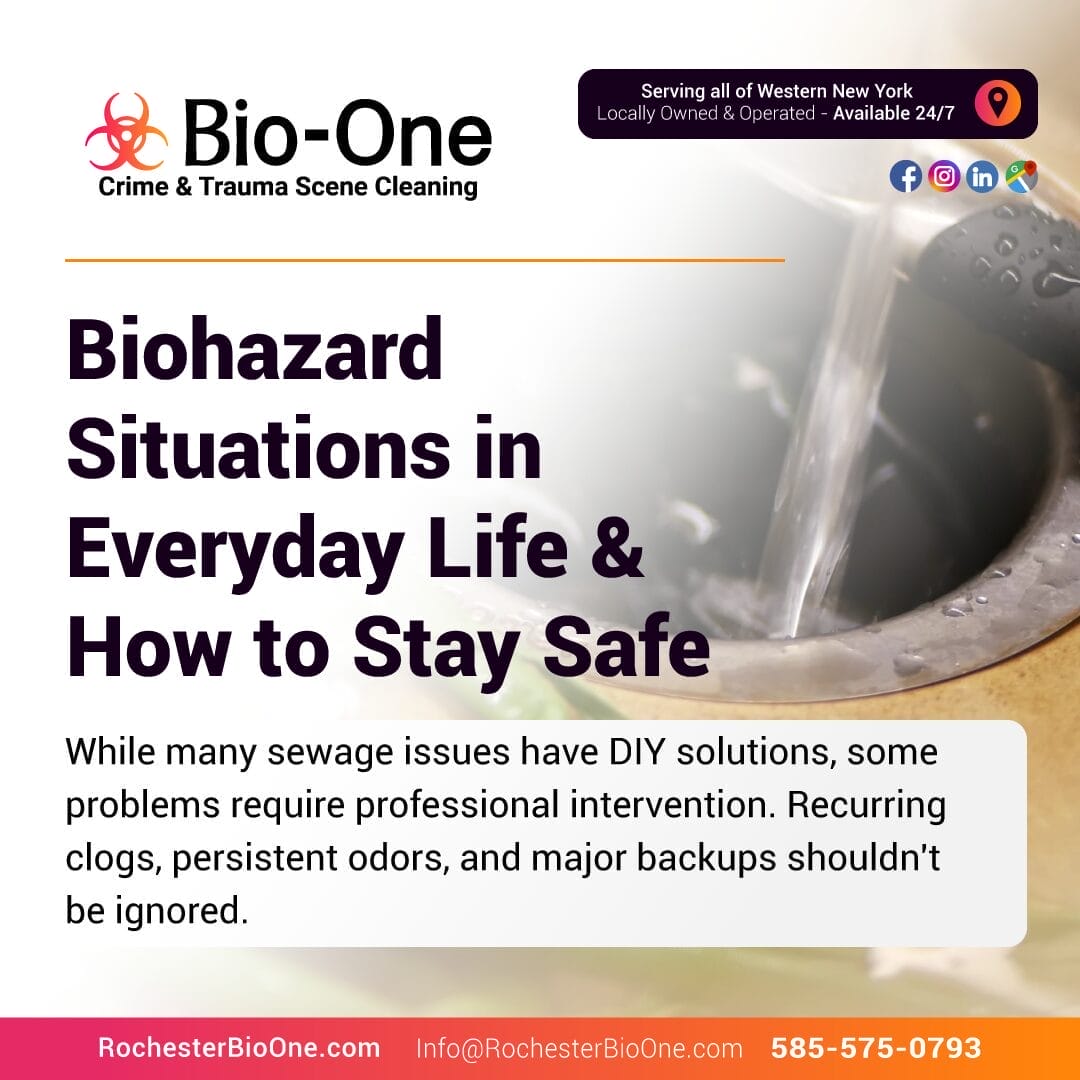
Owning a home comes with a world of joys and responsibilities. While decorating and landscaping might be the fun parts, dealing with sewage problems? Not so much. Yet, understanding the common issues that can arise in your sewage system is crucial for every homeowner. From simple clogs to more complex septic tank troubles, these problems can disrupt your daily life. This guide will help you identify common sewage issues and provide DIY solutions for some of them!
Sewage systems are intricate networks that work silently behind the scenes. The first step in tackling any problem is identifying what's wrong. Common issues include slow drains, unpleasant odors, and soggy lawns. Recognizing these signs early can save you from bigger headaches down the road.
A slow drain is often the first clue that something's amiss. It might be a simple clog in the pipe, but it could also indicate a more severe blockage in the system. Unpleasant odors, particularly near sinks or drains, can signal a buildup of waste materials. Meanwhile, unexpected wet patches in your yard might suggest a leaking or overflowing septic tank. By staying vigilant, you can catch these issues before they escalate.
Slow drains are a universal nuisance. They often result from hair, grease, or soap buildup in the pipes. Fortunately, many slow drains can be fixed with simple DIY solutions. The trusty plunger is your first line of defense. A few pumps might be all it takes to dislodge the blockage.
If plunging doesn't work, consider a homemade solution using baking soda and vinegar. Pour half a cup of baking soda followed by half a cup of vinegar down the drain. Wait for about 15 minutes, then flush it with hot water. This natural remedy can help break down grime and restore normal flow. However, if the problem persists, it might be time to seek professional help.
Unpleasant odors can make any home uncomfortable. If you notice foul smells coming from your drains, it's time to act. These odors are typically caused by waste buildup or stagnant water in pipes. Start by cleaning your drains regularly using a mixture of hot water and lemon juice. This not only removes odors but also prevents bacteria growth.
Another effective technique is to use a drain snake. This tool can reach deep into pipes to remove any trapped debris. Regular maintenance, like running hot water through your drains weekly, can also prevent future odor issues. Remember, persistent smells might indicate a more significant underlying problem, warranting a professional inspection.
Sewage backups are among the most dreaded household problems. They occur when wastewater flows back into your home, often due to blockages or damaged pipes. If you experience a backup, the first step is to stop using water immediately. This prevents additional wastewater from entering the system.
Using a plunger on affected drains could help alleviate minor backups. However, for extensive backups, it's essential to call in professionals like Bio-One of Rochester. We have the equipment and expertise to address the root cause effectively and safely.
Homes with septic systems occasionally face unique challenges. Issues like overflowing tanks or unpleasant smells can indicate problems. Regular pumping is vital to keep septic systems functioning well. However, if you notice soggy patches in your yard, it might mean your tank is either full or leaking.
While many sewage issues have DIY solutions, some problems require professional intervention. Recurring clogs, persistent odors, and major backups shouldn't be ignored. Professionals have specialized tools and knowledge to diagnose and fix complex problems, ensuring the issue is resolved correctly.
Bio-One of Rochester offers reliable sewage solutions for homeowners. With our expertise, we can handle everything from simple remediation to full-scale repairs. When DIY efforts fall short, reaching out for professional assistance can save you time, stress, and money in the long run!
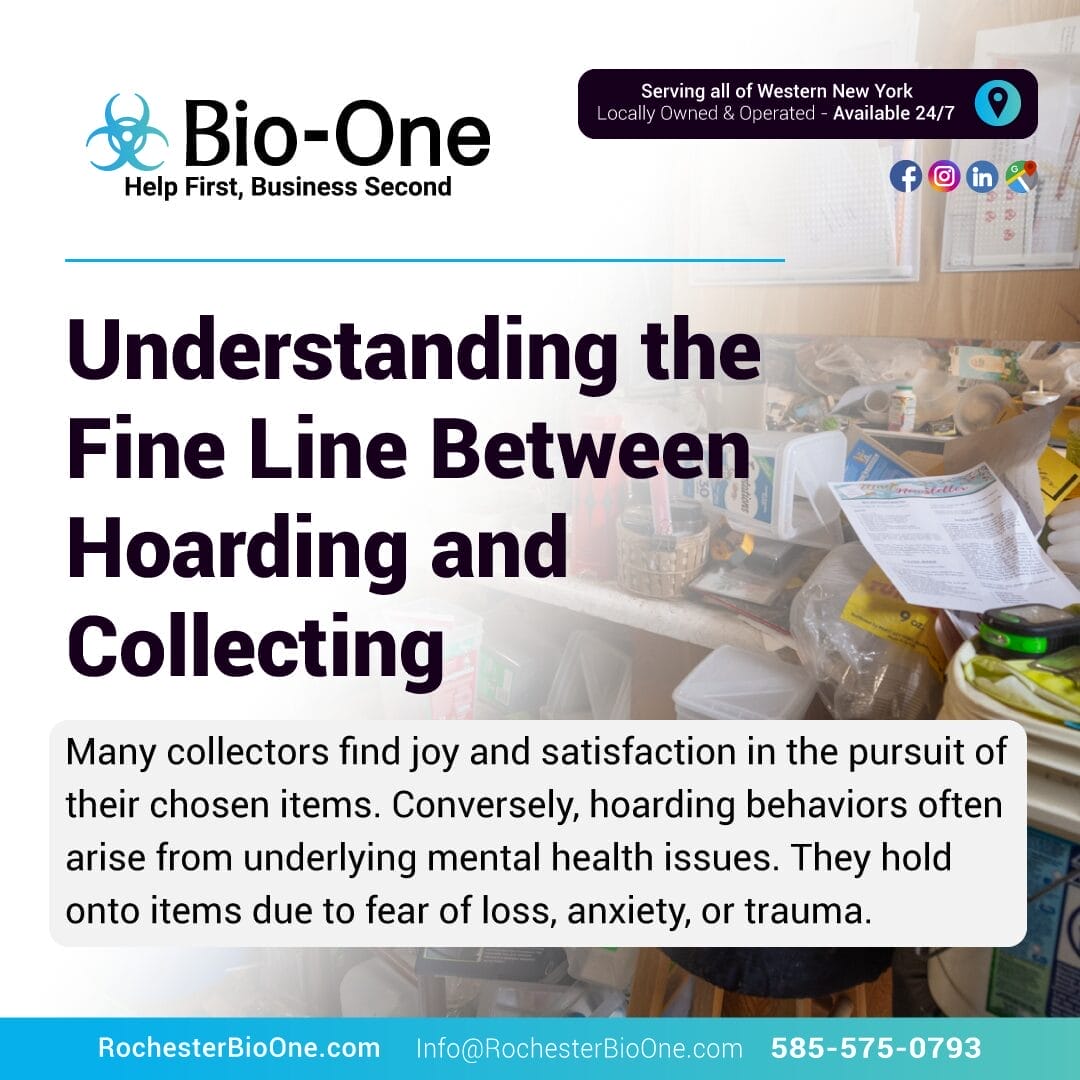
Have you ever wondered where collecting ends and hoarding begins? This line can often seem blurred, especially to those passionate about their treasures. In this blog post, we will unravel the differences between hoarding and collecting, explore the psychology behind these behaviors, and provide strategies for managing both.
Disclaimer
Please note that the information provided in this blog post is intended solely for educational purposes and to create awareness around hoarding. As a hoarding cleanup company, we bring expertise in managing clutter and restoring spaces, but we are not mental health professionals. We encourage readers facing challenges related to hoarding to seek assistance from qualified mental health professionals.
Hoarding refers to the excessive accumulation of items, often accompanied by an inability to discard them, regardless of their actual value. Collecting, on the other hand, involves intentionally gathering items with personal or financial significance. While both activities involve acquiring objects, they stem from different motivations and can lead to different outcomes.
Collecting is driven by a variety of emotional and psychological motivations. Many collectors find joy and satisfaction in the pursuit of their chosen items. This process often represents a connection to history, culture, or personal identity. For instance, a stamp collector might revel in the historical significance and artistry of each piece. Collecting can be a form of self-expression, allowing individuals to showcase their interests and achievements.

Conversely, hoarding behaviors often arise from underlying mental health issues. People who hoard may feel compelled to hold onto items due to fear of loss, anxiety, or trauma. Unlike collectors, hoarders may struggle with decision-making and organization. Their possessions can become a source of stress and embarrassment rather than pride. Understanding these psychological differences is crucial for recognizing and addressing hoarding tendencies.
Identifying the signs and symptoms of hoarding is essential for those who may be struggling or for families seeking to support a loved one:
Hoarding impacts not only the individual but also their family and immediate environment. It can create tension and conflict within households, as family members might feel burdened by the chaos.
Collections can provide a sense of identity to those who cherish them. Whether it's a set of vintage toys, rare coins, or classic cars, collections often hold sentimental or historical value. They can serve as a bridge to the past, connecting collectors to memories, cultures, and narratives.
However, the line between a valuable collection and hoarding can be thin. Collectors should regularly assess the purpose and impact of their collections. Does the collection enhance their life, or has it become overwhelming? Maintaining this balance is key to ensuring that collections remain a source of joy rather than a burden.

For individuals grappling with hoarding tendencies, there are many strategies to help regain control. Setting limits on acquisitions, organizing belongings, and prioritizing meaningful items are effective starting points. It's important to remember that change takes time, and gradual progress is better than none.
Nonetheless, seeking professional help is often the most effective way to address hoarding behaviors. Therapists specializing in cognitive-behavioral therapy can assist individuals in understanding the root causes of their hoarding and developing healthier habits. This might represent a significant improvement in mental well-being and overall quality of life.
If you or someone you know is struggling with hoarding behaviors, take the first step towards positive change. Share your story, seek support, and remember that you're not alone. Bio-One can help. We are a hoarding cleanup company, but our approach is much more compassionate and supportive than traditional cleaning services. Our team has the expertise and understanding to navigate hoarding situations with care, respect, and discretion.
Whether it's a small collection or an extreme hoarding situation, our goal is always to restore safety and dignity to your home. With Bio-One, you can trust that your possessions will be handled with sensitivity, while also ensuring a safe living environment!

A biohazard is any material that could potentially cause harm to humans or the environment. This includes things like blood and bodily fluids and bloodborne pathogens.
Potential biohazards can come from various sources, including hospitals, research labs, chemical spills, and animal remains. They can also come from trauma scenes, violent crimes, accidents, and natural disasters. It is crucial to take action quickly if you are faced with biohazard situations, as the risks associated with biohazards can be dangerous.
When incidents such as homicide occur, blood and body fluids may be left behind. Blood and body fluids may cause damage to a property or business, resulting in contaminated materials that professionals must remediate to avoid disease outbreaks.

When a home or company has been afflicted by violence, it automatically becomes a crime scene, as it's typically contaminated with blood spills and other dangerous pathogens. There should be a rapid attempt to clean it. Following the conclusion of the police investigation, crime scene cleanup and remediation services should be provided by professionals.
Biohazard remediation is critical in any hospital, research lab, or other health-related facilities. The improper treatment of biohazard materials can severely threaten both staff and patients.
Special care must be taken to avoid contact with biohazard situations, as they can pose a serious health risk. The material is then bagged and labeled according to OSHA regulations. The biohazard must be disposed of following State and Federal health regulations. Otherwise, health facilities may face potential lawsuits due to the proper handling of biohazard materials.
Biohazard cleanup should be a job for professionals who are trained in the proper procedures and safety precautions. Biohazard cleanup can be a dangerous and challenging process, and it is essential to ensure that the area is adequately restored to a safe, clean environment.
Chemical biohazards can be created from a number of different materials, including solvents, acids, tear gas, and bases. Airborne pathogens can cause a variety of injuries, including burns, skin irritation, and respiratory problems.

In addition, biohazards can also be created from the disposal of medical waste. This includes items such as syringes, bandages, and other potentially infectious materials that may pose a biological hazard. This medical waste can pose serious safety risks if not properly disposed of.
Biohazard prevention includes wearing the appropriate Personal Protective Equipment (PPE), such as gloves and masks, to avoid contact with biohazards. It is also important to properly clean and disinfect any areas that may have been contaminated.
Biohazard cleanup can be dangerous and should only be performed by professionals who have been trained in hazardous materials removal. If you are unsure of how to clean up a biohazard spill safely, contact a professional biohazard cleaner specialist for assistance.
When faced with a biohazardous situation, Bio-One of Rochester is the company to call for help. Our technicians are ready to help in life’s most difficult and unexpected situations with care, compassion, and discretion. Locally owned, we are proud to serve all of West New York, though our services expand Nationwide thanks to our +120 locations. If you’re struggling and need help, give us a call and let us take care of everything for you.
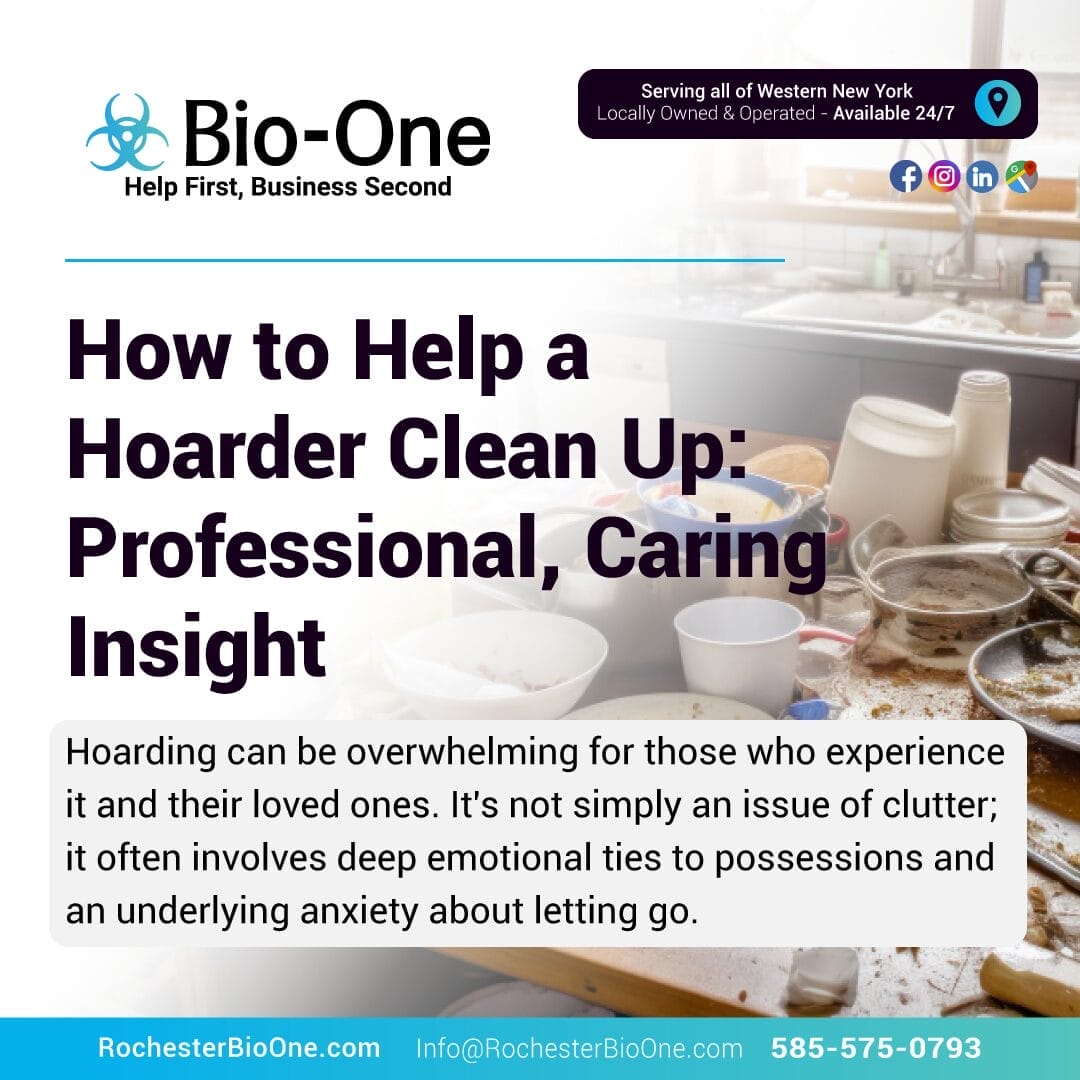
Hoarding can be overwhelming for those who experience it and their loved ones. It's not simply an issue of clutter; it often involves deep emotional ties to possessions and an underlying anxiety about letting go. Whether you are a family member, friend, or professional organizer, understanding how to approach this delicate situation with compassion and effectiveness is crucial. Here, you'll find expert advice on helping a hoarder clean up, highlighting practical strategies and empathetic support.
Before you can help effectively, it's important to understand hoarding as a mental health condition. Hoarding is characterized by persistent difficulty discarding possessions, causing cluttered living spaces and significant distress or impairment.
When assisting someone with hoarding tendencies, sensitivity is key. Harsh judgment or pressure to discard items can exacerbate anxiety and resistance.

Creating a structured plan can empower a hoarder to regain control over their environment. Collaborate with them to set realistic and achievable goals.
For a complete guide on how to help a hoarder clean up, visit our Hoarding Guide.
Professional organizers and therapists specializing in hoarding can provide valuable expertise and emotional support. They can offer tailored strategies and coping mechanisms to ease the decluttering process.
Encourage ongoing communication and provide reassurance throughout the cleanup process. Hoarders often fear losing their emotional connections to items, so it's vital to be patient and supportive.
Once initial progress is made, help the individual establish routines that prevent future hoarding behavior. This might include regular cleaning schedules and continued support.
By implementing these compassionate and practical strategies, you can play a crucial role in helping someone with hoarding their home and improve their quality of life.
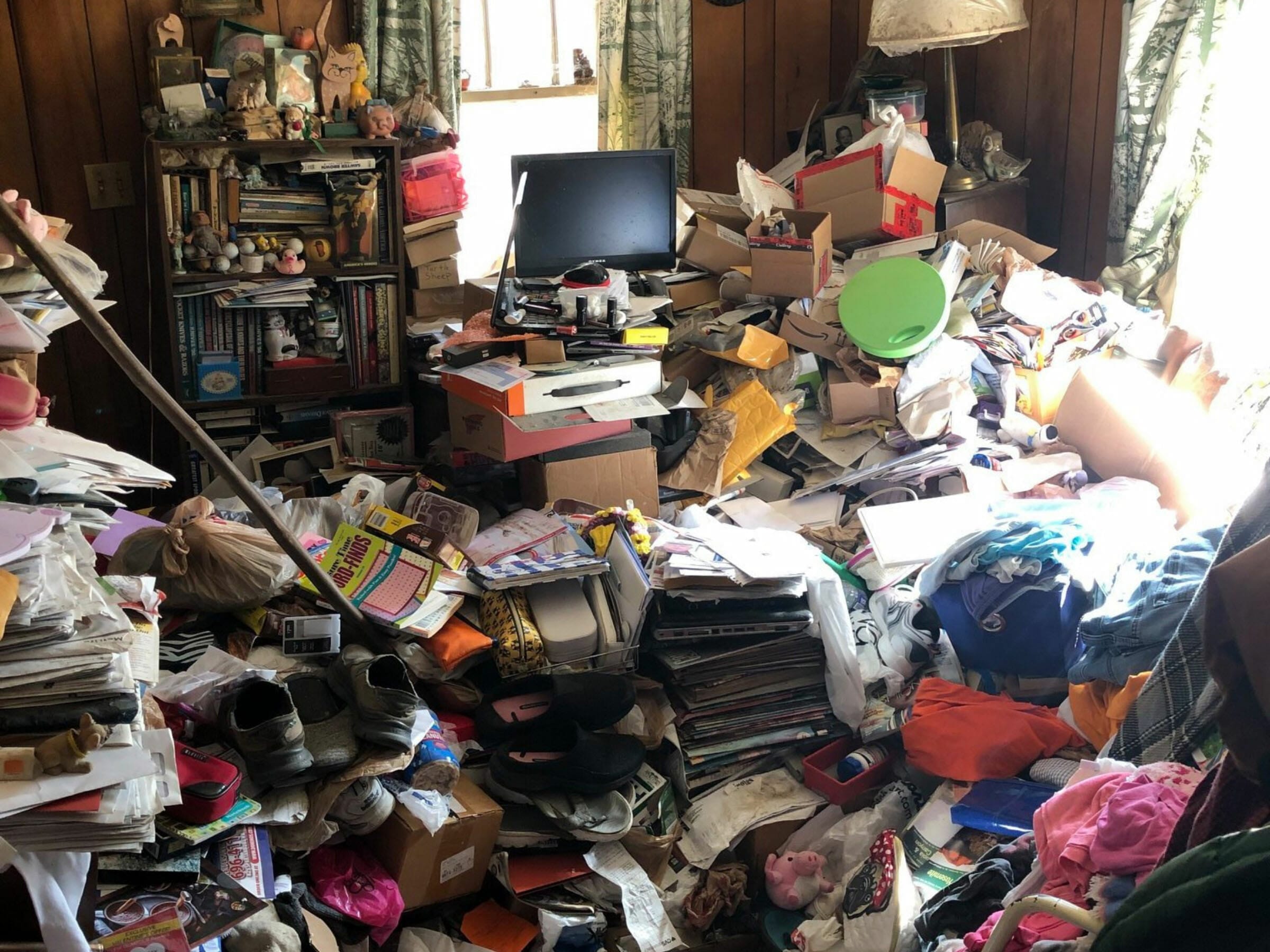
If you don't know how to help a hoarder clean up, Bio-One of Rochester is the company to call for help. Our technicians are ready to help in life’s most difficult and unexpected situations with care, compassion, and discretion. Locally owned, we are proud to serve all of West New York, though our services expand Nationwide thanks to our +120 locations. If you’re struggling and need help, give us a call, and let us take care of everything for you.